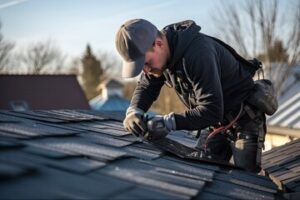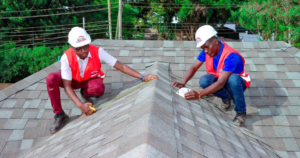From shingles and metal to tile and stone, roofs come in many different shapes, sizes and materials. Skilled roofing professionals can help you choose a material that suits your goals, architecture and budget.

Next, lay a layer of standard felt paper (or other waterproof underlayment) over the deck. A tacker tool makes it easy to secure the paper with staples. Visit https://arthursconstructionnc.com/best-greensboro-roofing-company/ to learn more.
The preparation process for roofing installation is a vital step that helps ensure the project goes smoothly. It also helps protect your home and landscaping from damage. A well-prepped roof will not only extend the life of your repairs, but it will help prevent future problems and complications.
The first step in the shingle replacement process is to remove and dispose of your old shingles. During this time, the roofing crew will also inspect the roof decking for any signs of damage or wear. If necessary, the roofer will repair and prime any areas that need attention before installing a new shingle layer.
It is essential that you clear the area around your home during a roof installation. This includes moving vehicles, removing patio furniture and grills, and temporarily relocating any plants that may be in the path of the work zone. Also, trim any overhanging trees to make the work area safer and easier for the roofers.
Before the shingle layers are installed, your roofer will apply an underlayment to the decking. This layer acts as a barrier between the shingles and the decking, protecting it from water infiltration. It is essential that the underlayment is properly adhered to the wood, as a poor bond can lead to leaks and other issues later on.
After the underlayment is applied, your roofer will install ice and water barriers to the eaves and roof valleys. This will help prevent water infiltration and reduce energy costs. These barriers are often referred to as “ice damming.” Additionally, flashing is often used around chimneys, wood stove pipes, certain vents, and along hip roofs.
Once all of the prep work is completed, it’s time to get started with the actual shingle replacement. The shingles are laid in layers and staggered, and they are either nailed or screwed in. This is an important step that helps your new roof look beautiful and last longer.
While the roofers are working, it’s important to keep your pets and children inside. The noise from hammers and nail guns can be quite disturbing to animals, especially dogs, who are very sensitive to sound. If possible, find alternate accommodations for your pets during this time to avoid stress and anxiety.
Installation
Once you’ve agreed on an estimate and signed a contract (if that was part of the process), it’s time for installation. Before they start work, our roofers will inspect your existing roof to ensure that there’s no additional damage and that the roof deck is strong enough to support a new roof. They’ll also add any needed flashing around chimneys, wood stove pipes, certain vents, or along hip rooflines. This protects your roof against rainwater, snow, ice, and debris.
Cleanup
A thorough cleanup is one of the most important aspects of any roofing job. Debris can damage your home, clog gutters, or pose safety hazards. Experienced roofing contractors have a dedicated crew that will ensure that all debris is removed and the work site is clean before leaving your property.
During the tear-off and installation processes, it’s likely that trash, wood scraps, and shingle fragments will be scattered around your property. To minimize this, experienced roofing contractors will use tarps to protect shrubs, plants, driveways, and walkways from falling debris. They will also place an industrial-size dumpster onsite to keep the mess contained.
This dumpster will be removed regularly so that a large amount of debris doesn’t accumulate on your property. This is especially helpful if you live in an area that experiences harsh weather, such as high winds or snow storms. In addition to keeping the debris contained, a dumpster will prevent odors from spreading throughout your home.
Some roofing contractors have a crew member dedicated to clean up, while others will take time to clear away debris and trash at multiple points throughout the day. They will be sure to check for any areas where tar stains may have caused staining on your gutters, siding, windowsills, and other surfaces.
To help keep your yard safe, a sweeper with a magnetic attachment is an excellent way to quickly and easily pick up nails that have been scattered in the lawn or garden beds. You should also consider hiring a professional cleaning service to clean up your property once the project is complete. They have the skills and equipment necessary to thoroughly clean the entire yard, including flowerbeds and other landscaping features.
Warranty
Manufacturer warranties, workmanship warranties, and extended warranty options are some of the primary protections homeowners can choose from to ensure a quality roofing installation. Each option offers different levels of coverage, so it’s important for homeowners to understand the distinctions and details. Understanding these differences empowers them to make informed decisions about their roofing project, ultimately protecting their investment and ensuring long-term peace of mind.
A standard manufacturer warranty provides the foundational layer of protection for your roofing materials, and typically lasts from 20 to 50 years. It covers any defects that may occur during the manufacturing process and can provide for complete replacement of damaged shingles or other roof components. These warranties can also cover any labor needed to repair or replace the faulty material.
Workmanship warranties offer additional protections, ensuring that the roofing contractor’s work meets or exceeds certain standards. These can range from basic limited lifetime warranties to workmanship guarantees that extend for the entire period that you own your home, providing a sense of confidence in the integrity of the roofing materials and the skill of the installers.
The type of workmanship warranty you choose depends on your needs and budget. A standard warranty is often free and provides limited protection, while an extended or comprehensive warranty will typically have a higher initial cost but will cover the costs of tear-off, disposal, and labor. Many reputable roofing contractors will offer these warranties, which can help reduce upfront costs and give you confidence in your roofing installation.
Extended and comprehensive warranties will include both material and workmanship coverage for a specified period, offering the most comprehensive protection. These warranties can be expensive but provide peace of mind and a sense of security that your roof will be protected throughout the lifespan of your home. Some manufacturers and roofing contractors will even offer transferable, lifetime warranties that can be passed on to any future homeowners. This will add value to your home and give potential buyers a confidence in the longevity of your roofing system.


